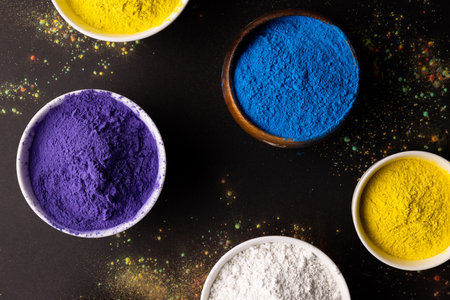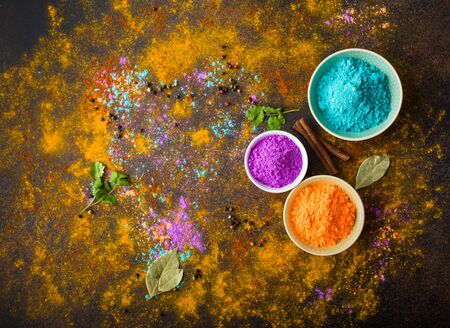1. Introduction: The Harmony of Psychology and Vastu
India’s rich cultural legacy has always emphasised the importance of harmonious living, and nowhere is this more evident than in the ancient science of Vastu Shastra. When combined with modern psychology, Vastu’s principles offer a powerful framework to enhance emotional and spiritual well-being through mindful colour selection. In today’s fast-paced Indian lifestyle, understanding how colours influence our mind, mood, and energy can be a game-changer—not just for personal happiness but also for family prosperity and business growth. By exploring the synergy between Vastu wisdom and psychological insights, you can discover how tailored colour choices create positive energy within your home or workspace, supporting holistic success in every aspect of life. This article will guide you on how to balance colours according to both Vastu Shastra and psychological principles, empowering you to curate spaces that uplift your spirit and attract abundance.
2. The Psychological Impact of Colours
Colours play a significant role in shaping our psychological state, influencing everything from mood and productivity to the quality of our relationships. Both Indian and global studies have shown that the human mind responds to colours at a subconscious level, making colour selection essential for creating a positive environment at home or work.
Understanding Colour Psychology
Colour psychology is the study of how different shades can trigger emotional and behavioural responses. For example, warm colours such as red and orange are energising and often associated with excitement and passion, while cool tones like blue and green promote calmness and relaxation. Indian culture has always emphasised the importance of colours, as reflected in traditional festivals like Holi and in Vastu Shastra principles.
Indian Perspective on Colour Influence
In India, each colour holds unique cultural significance. Yellow, for instance, is linked with knowledge and learning, commonly used in educational spaces. Saffron symbolises purity and spirituality, while green denotes harmony and prosperity. Studies conducted by Indian psychologists have confirmed that these associations can directly impact our mental state and interpersonal dynamics.
Global Insights on Colour Effects
Globally, research corroborates the influence of colours on human psychology. Western studies suggest that blue hues enhance concentration and efficiency, making them ideal for offices. In contrast, red may stimulate appetite and conversation, suitable for dining areas. Understanding these effects helps in crafting environments tailored for specific outcomes.
| Colour | Psychological Impact | Recommended Use (Vastu & Science) |
|---|---|---|
| Red | Stimulates energy, passion, appetite | Living rooms, dining areas (South or Southeast direction) |
| Blue | Calms mind, boosts focus | Study rooms, bedrooms (West or North direction) |
| Green | Balances emotions, promotes harmony | Pooja rooms, kitchens (North or East direction) |
| Yellow | Elicits positivity, enhances learning | Children’s rooms, study areas (Northeast direction) |
| Saffron/Orange | Sparks creativity, fosters spirituality | Meditation spaces (East direction) |
The synergy between scientific findings and Vastu recommendations allows us to strategically select colours that not only suit our personal taste but also optimise the flow of positive energy throughout our living or working space.

3. Vastu Shastra Essentials: Colour Principles for Indian Homes
In the heart of every Indian household, Vastu Shastra plays a pivotal role in shaping not only architectural choices but also the selection of colours that radiate energy and abundance. Traditional Vastu guidelines recommend specific colour palettes for different rooms, believing that each shade interacts with our psychological well-being and the flow of cosmic energy, or ‘prana,’ within the space.
Living Room: Inviting Prosperity & Social Harmony
The living room, often considered the social centre of an Indian home, benefits from light hues like cream, beige, or soft yellows. According to Vastu principles, these shades foster a welcoming atmosphere, attract financial luck, and enhance interpersonal relationships. Touches of green can also be introduced to symbolise growth and fresh beginnings.
Bedroom: Nurturing Peace & Marital Bliss
For bedrooms—especially master bedrooms—the emphasis is on soothing tones such as pastel blues, gentle pinks, or earthy neutrals. These colours calm the mind, promote restful sleep, and encourage harmony between couples. Avoid dark reds or black here, as they may disturb tranquility and create energetic imbalances.
Kitchen: Channeling Nourishment & Vitality
The kitchen represents nourishment and health in Vastu philosophy. Opt for vibrant yet balanced shades like light orange, lemon yellow, or subtle greens to stimulate appetite and positivity. These colours are believed to energize family members while ensuring the smooth flow of wealth and well-being.
Puja Room: Spiritual Elevation & Serenity
For the puja (prayer) room, white or light yellow is highly recommended. These hues signify purity and clarity of thought—ideal for spiritual practices. They create an aura of peace and facilitate a deeper connection with divine energies.
Bathrooms & Utility Spaces: Cleansing & Renewal
Soft blues or whites are suitable for bathrooms and utility areas as per Vastu Shastra. These shades evoke cleanliness and refreshment, helping to wash away negativity and rejuvenate both body and mind.
By aligning your home’s colour scheme with traditional Vastu Shastra wisdom, you not only harness positive psychological effects but also empower your space to attract abundance, peace, and success—the true hallmarks of a thriving Indian household.
4. Aligning Business Spaces: Colours for Growth and Financial Success
In India’s vibrant business landscape, the colours you choose for your office, shop, or business establishment can influence both financial fortunes and the overall mood of your workspace. According to Vastu Shastra, aligning colour selection with psychological principles creates an atmosphere that not only attracts prosperity but also enhances employee motivation and client trust. By understanding how each colour impacts mindset and energy flow, business owners can make strategic choices that foster growth and financial well-being.
Vastu-Approved Colours for Different Business Spaces
| Space Type | Recommended Colour | Psychological Benefit | Vastu Placement Tips |
|---|---|---|---|
| Main Office Area | Light Green / Cream | Encourages harmony and reduces stress; improves focus and collaboration among staff. | Apply on north or east walls to enhance fresh energy flow and attract new opportunities. |
| Cash Counter / Finance Desk | Royal Blue / Purple | Stimulates confidence, clarity, and strong decision-making for wealth management. | Place in the southeast zone to energize financial activity and secure transactions. |
| Reception / Waiting Area | Yellow / Off-white | Cultivates warmth, positivity, and a welcoming first impression for clients. | Use in the northeast direction to invite auspicious energies and create trust. |
| Manager’s Cabin | Wood Brown / Beige | Promotes stability, authority, and grounded leadership for effective management. | Opt for southwest placement to anchor decision power and long-term success. |
| Meeting Rooms | Pale Blue / Grey | Aids calm discussion, creative thinking, and consensus-building among teams. | Paint west-facing walls to support smooth communication and innovation. |
The Psychological Impact Behind Each Colour Choice
Green: Symbolising growth and renewal, green calms nerves and fosters teamwork—a must-have in spaces where new ideas are born.
Blue: Known to boost productivity and reduce anxiety; perfect for areas where important financial decisions are made.
Yellow: The colour of optimism—yellow energises visitors, makes your brand memorable, and triggers positive word-of-mouth.
Purple: Associated with wealth in Indian tradition; psychologically it enhances creativity and inspires confidence in negotiations.
Cream & Off-white: These neutral shades open up space visually while encouraging clarity of thought—ideal for customer-facing zones.
Browns & Beiges: Earthy hues ground energies, building trust among clients and providing a stable base for business operations.
Quick Tips for Indian Business Owners:
- Avoid using excessive red as it can trigger aggression or stress in high-pressure environments.
- Add subtle gold accents (in décor or signage) to invoke Lakshmi’s blessings for wealth according to Indian beliefs.
- If repainting is not possible, introduce recommended colours through furnishings or artwork placed in the appropriate directions per Vastu guidance.
- Mondays are considered auspicious for starting interior changes in business premises in many Indian communities—plan colour updates accordingly!
The Takeaway: Harmonise Vastu with Psychology for Prosperity
Selecting the right palette is more than aesthetics—it’s a strategic tool to balance Vastu energies with psychological comfort. By doing so, you empower your business environment to attract abundance, nurture productivity, and reflect the cultural richness of India’s enterprising spirit. Invest thoughtfully in colours; let your workspace radiate success from every corner.
5. Cultural Insights: Dos and Don’ts in Colour Choices
When integrating the principles of psychology and Vastu Shastra for positive energy in Indian spaces, it is essential to respect deeply rooted cultural customs around colour. India’s diverse traditions assign unique meanings to colours, which can empower business environments or homes when used wisely. Below are key dos and don’ts that align with both modern psychological research and Vastu practices, ensuring your choices resonate positively within the local context.
Dos: Harnessing Positive Traditions
Use Auspicious Colours Strategically
Saffron and yellow are seen as sacred and energising in Indian culture. Use these shades in entrances or workspaces to invoke optimism, clarity, and spiritual growth—qualities both Vastu and modern psychology associate with productivity and positivity.
Respect Red’s Symbolism
Red is widely regarded as a symbol of prosperity, passion, and power. It is ideal for accent walls in living rooms or boardrooms but should be balanced with neutral tones to avoid overstimulation—a tip supported by psychological studies on emotional regulation.
Embrace Green for Balance
Green represents harmony, renewal, and financial stability in Vastu. Incorporate green elements in north or east-facing areas to promote growth and fresh energy, aligning with psychological findings that suggest greenery reduces stress and enhances creativity.
Don’ts: Avoiding Cultural Missteps
Avoid Excessive Black or Grey
In Indian tradition, black often signifies negativity or mourning, while grey can create feelings of stagnation. Use these shades sparingly, especially in key areas like entryways or prayer rooms, to prevent blocking positive energy flow as advised by Vastu experts.
Be Mindful with White during Ceremonies
While white denotes purity and peace in both psychological terms and Vastu, it is also traditionally worn at funerals in India. Avoid overusing pure white during celebratory occasions or festive spaces; instead, blend it with vibrant hues to maintain balance and respect local sentiments.
Blending Modern Insights with Tradition
The key to successful colour balancing lies in combining the ancient wisdom of Vastu with contemporary psychological insights. By honouring India-specific customs—such as using auspicious colours for prosperity zones and avoiding taboo shades in sacred spaces—you not only enhance positive energy but also foster respect for tradition within modern living or business environments.
6. Practical Tips: Infusing Your Space with Positive Energy
Understanding Urban and Traditional Indian Spaces
Whether you reside in a bustling Mumbai apartment or a serene ancestral home in Jaipur, blending Vastu Shastra with psychological colour principles can elevate your living environment’s energy. The unique needs of urban and traditional Indian settings require mindful adaptation of colour schemes to support both functionality and cultural harmony.
Wall Colours: Foundation of Positive Vibes
Begin by choosing wall colours that respect both Vastu directions and psychological impact. For example, paint the northeast walls light blue or green to invoke calmness and spiritual growth—perfect for meditation corners or study areas. In the south or southwest, opt for earthy tones like terracotta or beige to promote stability and grounding, especially suitable for master bedrooms or family rooms.
Décor Accents: Layering Energies
Enhance your chosen palette with décor items such as cushions, curtains, and rugs in complementary shades. In urban homes where space is limited, use vibrant accents like saffron or yellow to energise compact living rooms without overwhelming them. For traditional spaces, incorporate classic Indian prints and textures that align with recommended Vastu colours—think block-printed bedspreads or handwoven dhurries in auspicious hues.
Cultural Touchstones: Blending Heritage and Psychology
Infuse your interiors with meaningful objects that echo Indian heritage and foster positive psychology. Place brass diyas (lamps) in the east for new beginnings, or hang traditional Madhubani art featuring soothing greens and blues for creative inspiration. These elements not only honour cultural roots but also reinforce positivity through their symbolic resonance.
Practical Steps for Implementation
- Start small: Experiment with accent walls before committing to a full-colour overhaul.
- Consult local artisans: Source natural pigments or handcrafted décor aligned with Vastu colours.
- Balance is key: Avoid overly saturated or clashing hues; seek harmony across all elements.
- Personalise thoughtfully: Integrate family heirlooms or spiritual symbols in rooms facing auspicious directions.
Sustaining Energy Flow
Regularly refresh your space by rotating décor according to seasons or festivals—swap out summer brights for winter earth tones, always aligning with both Vastu guidelines and your emotional needs. This dynamic approach ensures your home remains a living source of positive energy, prosperity, and well-being throughout the year.
7. Conclusion: Sustainable Energy Through Balanced Colours
In the dynamic context of Indian homes and workplaces, the conscious selection of colours, guided by both psychology and Vastu principles, offers a pathway to holistic well-being. By mindfully balancing hues that align with one’s aspirations and emotional needs, we invite not only prosperity but also deep emotional harmony into our daily environments. As Vastu Shastra teaches us, each colour radiates a unique energy; when applied thoughtfully to different directions and spaces, these energies can elevate mood, boost productivity, and foster harmonious relationships. Psychologically, colours can stimulate positivity or calmness based on their placement and intensity. When both traditions are integrated, they empower individuals to create sustainable energy flows that nurture growth—be it for a thriving business in Mumbai or a peaceful home in Chennai. In summary, investing attention in balanced colour schemes is an investment in lasting abundance and happiness, making every space a source of positive transformation and continuous success.


